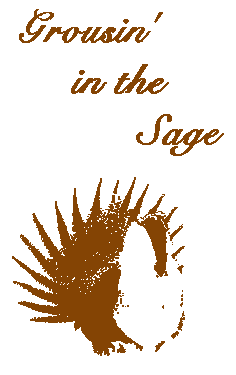






powered by SignMyGuestbook.com

| Newest
Older Previous Next Random Contact Profile Host |
blizzard warnings - 13:52 , 03 October 2013 heelerless - 21:32 , 18 August 2013 Red Coat Inn in Fort McLeod - 11:38 , 23 June 2013 rushing into the waters - 09:53 , 21 June 2013 choosing a spot - 17:43 , 27 April 2013 |
11,225 antelope
I don't really have an entry for today. Work wise, I spent most of my time typing numbers into a text file in the format necessary for our antique software for analyzing line transect data.
Now, I suppose I should explain line transect surveys.
Long ago, managers figured out that you could get a fair estimate of animal populations by flying strip counts, rather than trying to do expensive, long total counts. The idea was, you mark a narrow strip on the strut of the plane with dowels or ribbon, spacing it so that the ground visible through that strip will be a known width at a standard height (usually 300').
Statistically, you can get a reliable estimate, often at one tenth the cost of a total count (or less if you're flying a big enough area, like western Australia).
Problem is, just as you know you're not seeing all the animals in a "total" count, you also know you don't see them all in a strip survey. Generally, the farther out from the observer that the strip goes, the more you miss.
And knowing how many you missed makes all the difference.
The idea behind the line transect survey is to fly four strip surveys at once. Four narrow strips, side-by-side, keeping track of which strip the critters are in. This then gives you a bar graph with four bars, with distance on the horizontal axis and critter numbers on the verticle (weren't expecting algebra when you logged on here today, were you?).
As expected, the number of animals almost always drops off noticeably in the third and fourth strip.
Plotting a curve against the tops of these four bar graphs then gives you a means of estimating detectability of critters at varying distances from the plane.
Cool, but not the main point of flying these surveys.
If the observers fly the survey properly, concentrating on not missing a single critter in the innermost band, the point where the curve fitted to the bar graphs crosses the zero line will be your density of animals.
In our case, in pronghorn/mi2. Based upon 954.9 miles of transects.
Of course, things always get complicated. The width of your strips varies with the height of the plane. So it is equipped with a radar altimeter that automatically records above ground height for each and every of the antelope groups spotted (238 groups in our case).
And you then have to recalculate the width of each strip at each of those 238 sightings.
Lorinda, is this the type of data processing you would like to do? It's tedious, boring, and needs to be double checked to catch any typing errors. Maybe I'll send it to you for the typing next time.
When things go well, the analysis is usually straight forward. But when dealing with critters, things rarely go well. In our case, and as happened quite a few times before, the observers saw more animals in the second strip than they did in the first.
Not supposed to happen.
But it does.
Either 1) the antelope are messing with us, shifting themselves 50 meters off the longitudinal lines, or 2) the observers missed antelope in the first strip. (Which is quite tiring to watch... you're flying with your head "resting" near the glass, keeping the little black line on the window in perfect alignment with the first black dowel. When "on line", you can neither raise, lower or turn your head. Some lines are over 50 miles long, with no break.), or 3) some antelope are spooking from the plane and running from the first strip into the second before they are spotted.
In either case, the curve will not line up correctly with the four bars, and you have to eyeball which curve gives the "best" fit.
So, after several hours of comparison, I have our estimate: 3.34 pronghorn/mi2. Over 3,361 square miles of occupied habitat yields an estimate of 11,225 antelope.
Where we had been expecting to find 13,000 antelope. Now comes the discussion of whether we need to bother the Governor to get an emergency regulation to reduce the licenses this fall, or if we can still grow antelope with the quotas we already have.
Spent the afternoon drafting and sending the memo with my opinion on the subject. Now we wait to hear what the wardens and bosses have to say.